by Bryan Perry
July 25, 2023
All through 2022, the energy sector was the standout performer, as the major averages were broadly lower over the same time frame. The sanctions on Russian oil, coupled with the economy rebounding from the pandemic and an anti-fossil fuel policy within the Biden Administration, provided a trifecta of catalysts for the energy patch, showing up in the form of energy companies reducing capex spending, initiating huge stock buy-backs, and hiking dividend payouts in both fixed and variable dividends.
The S&P 500 Energy Sector SPDR ETF (XLE) roared 130% higher last year, closing on a constructive pullback that had most energy bulls looking for a continuation of the rally as 2023 got under way.
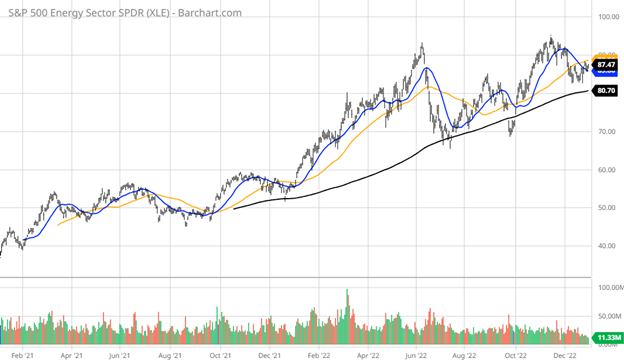
Graphs are for illustrative and discussion purposes only. Please read important disclosures at the end of this commentary.
For a while, the bulls were right, as the energy sector rose by a little over 6% in January 2023, but from that point on, energy stocks were deeply impacted, especially during March as recession fears devoured many global markets, illustrated in the year-to-date chart below, showing a steep March sell-off.
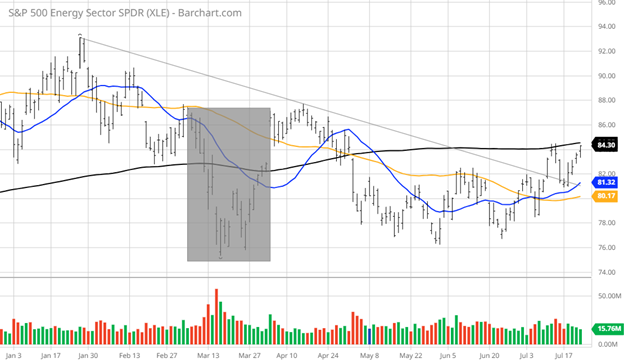
Graphs are for illustrative and discussion purposes only. Please read important disclosures at the end of this commentary.
The dominant narrative was that the market would almost assuredly retest the October 2022 lows, which would represent a correction on the order of around 15%, using the S&P 500 as the benchmark.
The 2022 rally in energy coincided with inflation spiking, along with the Fed desperately raising rates after their now-infamous “inflation is transitory” policy statement went up in smoke when core inflation hit 9.2% in June 2022. The CPI is now running at an annual pace of 3.0% as of June’s reading.
A big contributor to lower inflation is seeing oil and gas prices revisiting their March lows in June.
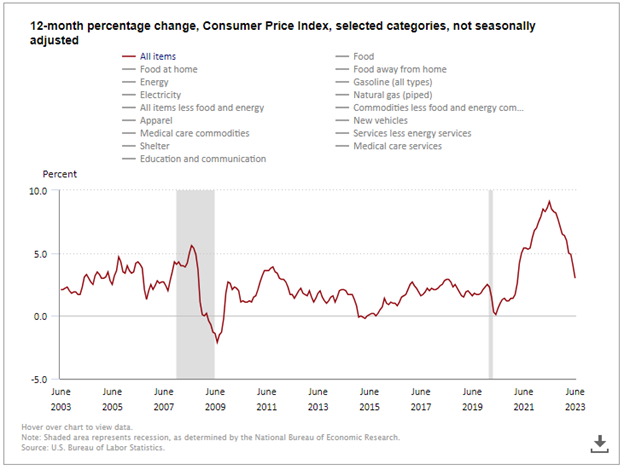
Graphs are for illustrative and discussion purposes only. Please read important disclosures at the end of this commentary.
In July, all that looks to be changing, as shares of the XLE have clearly broken the downtrend line going back to January. Leading the fresh upside move have been oil services stocks – companies that support the oil and gas industry, including energy exploration, transport, and the processing and delivery of energy assets to market. This subsector has seen price surges the past two weeks, trading up through its 200-day moving average like a hot knife through butter to challenge the previous 52-week high.
This stunning move has received little mention by the financial media, which has placed so much focus on AI. Such a breakout move by oil service stocks often precedes a larger move within the broader sector, especially at a time when a weak China has kept a lid on refiners and integrated oil and gas companies.
We have also seen a sudden change in price action of the refiners in the past two weeks, with the leading names all posting very bullish moves higher. And while the biggest oil majors are still near the low end of their respective trading ranges, they too are now firming up in what could be seen as a big reversal in the making, as investors grow more positive on the economy surviving the threat of recession.
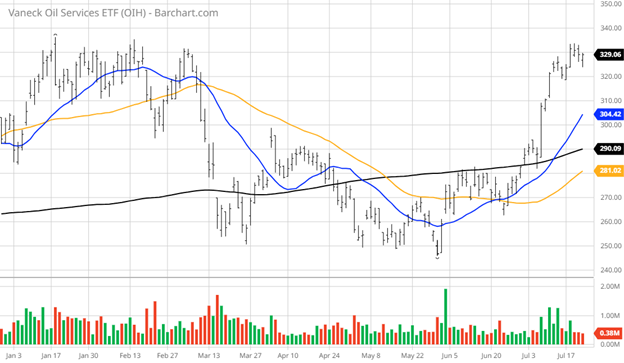
Graphs are for illustrative and discussion purposes only. Please read important disclosures at the end of this commentary.
It seems like a majority of investors believe that our central bank interest rate hikes to fight inflation should keep a lid on global growth for the time being. And yet there is clear evidence from recent price action that some investors are positioning their portfolios for a rebound in energy stocks, lured by attractive valuations and signs the U.S. will continue to sidestep a downturn of any significant magnitude.
This month, UBS upgraded energy to “most preferred” status, citing dwindling supply and signs that a U.S. recession, if it comes at all, may be less severe than expected. “We don’t have a recession as our base-case scenario in the U.S., so we think there is scope for the laggards to catch up,” said David Lefkowitz, senior equity strategist at UBS Wealth Management. “Energy is at the top of that list.”
Also, analysts at TD Securities said oil production cuts from Saudi Arabia and supply reductions from OPEC+ “are likely to more than offset the surplus accumulated in the first half of 2023,” lifting the price of U.S. West Texas Intermediate (WTI) to $90 per barrel. That’s 16% higher than where WTI currently trades at $77 per barrel, which is already $10 higher than where it was trading in the last week of June.
So, just when no one was wanting to back up the truck and buy energy stocks, the latest move has investors believing this sudden surge is more of an oversold bounce than a new and sustainable uptrend emerging. It’s hard to say, but it makes one wonder if we’ve seen the low in inflation this year as the CRB Commodity Index rose above 308 and sits at a fresh 2023 high amid a weak dollar and high food inputs.
Bloomberg said last Friday: “Agricultural commodities, which account for more than 40% of the index, resumed the upward trend after prices for cocoa, corn, soybeans, and sugar increased on shortage fears. Also, the cost of wheat surged following Russia’s suspension of a shipping deal with one of the world’s biggest producers. WTI crude returned above $75 per barrel thanks to China’s pledge to roll out more policies, and natural gas soared above $2.7/MMBtu on expectations of stronger air conditioning demand.”
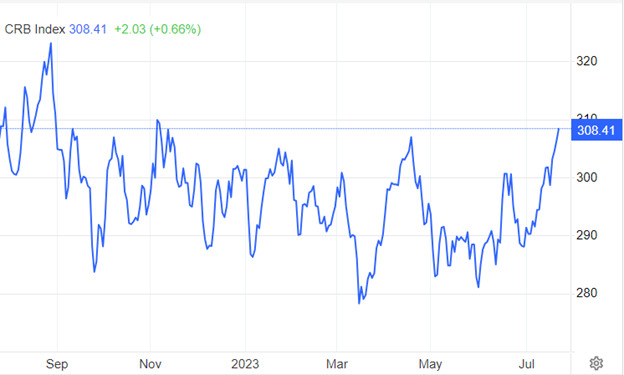
Graphs are for illustrative and discussion purposes only. Please read important disclosures at the end of this commentary.
At present, there is only a 15% probability of a Fed rate increase at the September 20 FOMC meeting. Based on what is now happening with energy and commodities, that number could easily start moving north of 50% if oil, natural gas, and other commodity prices keep heading higher. That said, it might be time to consider energy stocks trading at steep discounts with their large fixed and variable dividends.
All content above represents the opinion of Bryan Perry of Navellier & Associates, Inc.
Also In This Issue
A Look Ahead by Louis Navellier
China is “Losing its Mojo” Under Dictator-for-Life, Xi Jinping
Income Mail by Bryan Perry
A Rally in The Energy Sector Is Taking Shape
Growth Mail by Gary Alexander
Huge Boomer Assets Should Fuel More Market Growth
Global Mail by Ivan Martchev
The Broad Market Finds its Pulse
Sector Spotlight by Jason Bodner
Record Cash on Sidelines Says Millions Missed this Rally
View Full Archive
Read Past Issues Here

Bryan Perry
SENIOR DIRECTOR
Bryan Perry is a Senior Director with Navellier Private Client Group, advising and facilitating high net worth investors in the pursuit of their financial goals.
Bryan’s financial services career spanning the past three decades includes over 20 years of wealth management experience with Wall Street firms that include Bear Stearns, Lehman Brothers and Paine Webber, working with both retail and institutional clients. Bryan earned a B.A. in Political Science from Virginia Polytechnic Institute & State University and currently holds a Series 65 license. All content of “Income Mail” represents the opinion of Bryan Perry
Important Disclosures:
Although information in these reports has been obtained from and is based upon sources that Navellier believes to be reliable, Navellier does not guarantee its accuracy and it may be incomplete or condensed. All opinions and estimates constitute Navellier’s judgment as of the date the report was created and are subject to change without notice. These reports are for informational purposes only and are not a solicitation for the purchase or sale of a security. Any decision to purchase securities mentioned in these reports must take into account existing public information on such securities or any registered prospectus.To the extent permitted by law, neither Navellier & Associates, Inc., nor any of its affiliates, agents, or service providers assumes any liability or responsibility nor owes any duty of care for any consequences of any person acting or refraining to act in reliance on the information contained in this communication or for any decision based on it.
Past performance is no indication of future results. Investment in securities involves significant risk and has the potential for partial or complete loss of funds invested. It should not be assumed that any securities recommendations made by Navellier. in the future will be profitable or equal the performance of securities made in this report. Dividend payments are not guaranteed. The amount of a dividend payment, if any, can vary over time and issuers may reduce dividends paid on securities in the event of a recession or adverse event affecting a specific industry or issuer.
None of the stock information, data, and company information presented herein constitutes a recommendation by Navellier or a solicitation to buy or sell any securities. Any specific securities identified and described do not represent all of the securities purchased, sold, or recommended for advisory clients. The holdings identified do not represent all of the securities purchased, sold, or recommended for advisory clients and the reader should not assume that investments in the securities identified and discussed were or will be profitable.
Information presented is general information that does not take into account your individual circumstances, financial situation, or needs, nor does it present a personalized recommendation to you. Individual stocks presented may not be suitable for every investor. Investment in securities involves significant risk and has the potential for partial or complete loss of funds invested. Investment in fixed income securities has the potential for the investment return and principal value of an investment to fluctuate so that an investor’s holdings, when redeemed, may be worth less than their original cost.
One cannot invest directly in an index. Index is unmanaged and index performance does not reflect deduction of fees, expenses, or taxes. Presentation of Index data does not reflect a belief by Navellier that any stock index constitutes an investment alternative to any Navellier equity strategy or is necessarily comparable to such strategies. Among the most important differences between the Indices and Navellier strategies are that the Navellier equity strategies may (1) incur material management fees, (2) concentrate its investments in relatively few stocks, industries, or sectors, (3) have significantly greater trading activity and related costs, and (4) be significantly more or less volatile than the Indices.
ETF Risk: We may invest in exchange traded funds (“ETFs”) and some of our investment strategies are generally fully invested in ETFs. Like traditional mutual funds, ETFs charge asset-based fees, but they generally do not charge initial sales charges or redemption fees and investors typically pay only customary brokerage fees to buy and sell ETF shares. The fees and costs charged by ETFs held in client accounts will not be deducted from the compensation the client pays Navellier. ETF prices can fluctuate up or down, and a client account could lose money investing in an ETF if the prices of the securities owned by the ETF go down. ETFs are subject to additional risks:
- ETF shares may trade above or below their net asset value;
- An active trading market for an ETF’s shares may not develop or be maintained;
- The value of an ETF may be more volatile than the underlying portfolio of securities the ETF is designed to track;
- The cost of owning shares of the ETF may exceed those a client would incur by directly investing in the underlying securities; and
- Trading of an ETF’s shares may be halted if the listing exchange’s officials deem it appropriate, the shares are delisted from the exchange, or the activation of market-wide “circuit breakers” (which are tied to large decreases in stock prices) halts stock trading generally.
Grader Disclosures: Investment in equity strategies involves substantial risk and has the potential for partial or complete loss of funds invested. The sample portfolio and any accompanying charts are for informational purposes only and are not to be construed as a solicitation to buy or sell any financial instrument and should not be relied upon as the sole factor in an investment making decision. As a matter of normal and important disclosures to you, as a potential investor, please consider the following: The performance presented is not based on any actual securities trading, portfolio, or accounts, and the reported performance of the A, B, C, D, and F portfolios (collectively the “model portfolios”) should be considered mere “paper” or pro forma performance results based on Navellier’s research.
Investors evaluating any of Navellier & Associates, Inc.’s, (or its affiliates’) Investment Products must not use any information presented here, including the performance figures of the model portfolios, in their evaluation of any Navellier Investment Products. Navellier Investment Products include the firm’s mutual funds and managed accounts. The model portfolios, charts, and other information presented do not represent actual funded trades and are not actual funded portfolios. There are material differences between Navellier Investment Products’ portfolios and the model portfolios, research, and performance figures presented here. The model portfolios and the research results (1) may contain stocks or ETFs that are illiquid and difficult to trade; (2) may contain stock or ETF holdings materially different from actual funded Navellier Investment Product portfolios; (3) include the reinvestment of all dividends and other earnings, estimated trading costs, commissions, or management fees; and, (4) may not reflect prices obtained in an actual funded Navellier Investment Product portfolio. For these and other reasons, the reported performances of model portfolios do not reflect the performance results of Navellier’s actually funded and traded Investment Products. In most cases, Navellier’s Investment Products have materially lower performance results than the performances of the model portfolios presented.
This report contains statements that are, or may be considered to be, forward-looking statements. All statements that are not historical facts, including statements about our beliefs or expectations, are “forward-looking statements” within the meaning of The U.S. Private Securities Litigation Reform Act of 1995. These statements may be identified by such forward-looking terminology as “expect,” “estimate,” “plan,” “intend,” “believe,” “anticipate,” “may,” “will,” “should,” “could,” “continue,” “project,” or similar statements or variations of such terms. Our forward-looking statements are based on a series of expectations, assumptions, and projections, are not guarantees of future results or performance, and involve substantial risks and uncertainty as described in Form ADV Part 2A of our filing with the Securities and Exchange Commission (SEC), which is available at www.adviserinfo.sec.gov or by requesting a copy by emailing info@navellier.com. All of our forward-looking statements are as of the date of this report only. We can give no assurance that such expectations or forward-looking statements will prove to be correct. Actual results may differ materially. You are urged to carefully consider all such factors.
FEDERAL TAX ADVICE DISCLAIMER: As required by U.S. Treasury Regulations, you are informed that, to the extent this presentation includes any federal tax advice, the presentation is not written by Navellier to be used, and cannot be used, for the purpose of avoiding federal tax penalties. Navellier does not advise on any income tax requirements or issues. Use of any information presented by Navellier is for general information only and does not represent tax advice either express or implied. You are encouraged to seek professional tax advice for income tax questions and assistance.
IMPORTANT NEWSLETTER DISCLOSURE:The hypothetical performance results for investment newsletters that are authored or edited by Louis Navellier, including Louis Navellier’s Growth Investor, Louis Navellier’s Breakthrough Stocks, Louis Navellier’s Accelerated Profits, and Louis Navellier’s Platinum Club, are not based on any actual securities trading, portfolio, or accounts, and the newsletters’ reported hypothetical performances should be considered mere “paper” or proforma hypothetical performance results and are not actual performance of real world trades. Navellier & Associates, Inc. does not have any relation to or affiliation with the owner of these newsletters. There are material differences between Navellier Investment Products’ portfolios and the InvestorPlace Media, LLC newsletter portfolios authored by Louis Navellier. The InvestorPlace Media, LLC newsletters contain hypothetical performance that do not include transaction costs, advisory fees, or other fees a client might incur if actual investments and trades were being made by an investor. As a result, newsletter performance should not be used to evaluate Navellier Investment services which are separate and different from the newsletters. The owner of the newsletters is InvestorPlace Media, LLC and any questions concerning the newsletters, including any newsletter advertising or hypothetical Newsletter performance claims, (which are calculated solely by Investor Place Media and not Navellier) should be referred to InvestorPlace Media, LLC at (800) 718-8289.
Please note that Navellier & Associates and the Navellier Private Client Group are managed completely independent of the newsletters owned and published by InvestorPlace Media, LLC and written and edited by Louis Navellier, and investment performance of the newsletters should in no way be considered indicative of potential future investment performance for any Navellier & Associates separately managed account portfolio. Potential investors should consult with their financial advisor before investing in any Navellier Investment Product.
Navellier claims compliance with Global Investment Performance Standards (GIPS). To receive a complete list and descriptions of Navellier’s composites and/or a presentation that adheres to the GIPS standards, please contact Navellier or click here. It should not be assumed that any securities recommendations made by Navellier & Associates, Inc. in the future will be profitable or equal the performance of securities made in this report.
FactSet Disclosure: Navellier does not independently calculate the statistical information included in the attached report. The calculation and the information are provided by FactSet, a company not related to Navellier. Although information contained in the report has been obtained from FactSet and is based on sources Navellier believes to be reliable, Navellier does not guarantee its accuracy, and it may be incomplete or condensed. The report and the related FactSet sourced information are provided on an “as is” basis. The user assumes the entire risk of any use made of this information. Investors should consider the report as only a single factor in making their investment decision. The report is for informational purposes only and is not intended as an offer or solicitation for the purchase or sale of a security. FactSet sourced information is the exclusive property of FactSet. Without prior written permission of FactSet, this information may not be reproduced, disseminated or used to create any financial products. All indices are unmanaged and performance of the indices include reinvestment of dividends and interest income, unless otherwise noted, are not illustrative of any particular investment and an investment cannot be made in any index. Past performance is no guarantee of future results.
